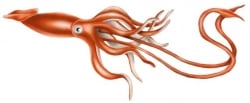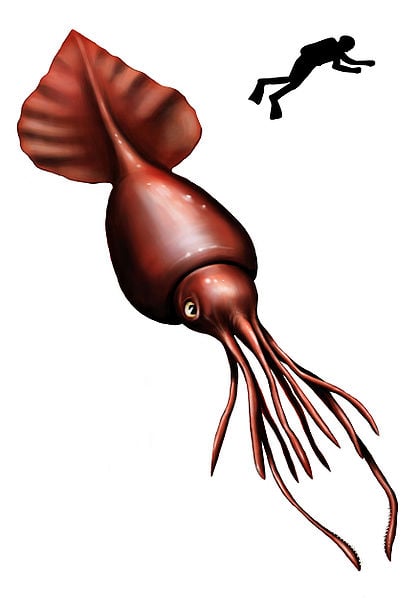The Real Kraken: The Giant Squid

The giant squid, found in all of the world's oceans, is a deep-sea dwelling creature in the family Architeuthidae.
The only known predator of an adult giant squid is the sperm whale, while juveniles are preyed upon only by deep sea sharks and other fishes.
On September 30, 2004,Japanese researchers took the very first photographs of the giant squid in its natural habitat. They were able to obtain video of a live giant squid later that year.
Until then, only dead specimens had been located and studied. It is this elusiveness, along with its tremendous size, that established the giant squid as a ferocious and mysterious creature in the human mythos.
Worldwide Distribution Of The Giant Squid

The Giant Squid in History and Culture
Until the 2004 photographs were released, knowledge of the giant squid had been obtained only from examination of dead (and usually quite decayed) specimens along with writings, myths and legends.
The 'Kraken'legend dates back to Norse tales of a tentacled sea monster as large as an island. Such literary and film works as Moby Dick, Twenty Thousand Leagues Under The Sea, and Dr. No likewise portray a giant squid or kraken. Pliny the Elder, who lived in the first century A.D., described a giant squid with a head "as big as a cask", arms 30 ft. long, and a weight of 700 pounds.

Anatomy of the Giant Squid
All Squid have a torso, called the mantle, eight arms, and two tentacles which are longer than the arms. The arms and tentacles of the squid make up most of its length.
As with all cephalopods, the arms and tentacles of the squid are lined with hundreds of spherical suction cups arranged in two rows. The outer rims of the suckers are lined with very sharp rings of chitin, or teeth, which allow the squid to attach itself to prey. At the center of all the arms and tentacles is the squid's beak, which resembles a parrot's beak in both form and function.
Giant squid have the largest eyes of any living creature except the colossal squid. Their eyes measure more than 1 foot in diamenter, larger than your average dinner plate. This great size helps them detect even small differences in light in the deep water environment in which they live.
Learn More About the Giant Squid

How Giant IS the Giant Squid?
The giant squid exhibits 'reverse sexual dimorphism.' This means that the females of the species are larger than the males. Scientists, after studing hundreds of dead giant squid specimens and parts of specimens, estimate that the giant squid grows to a maximum size of 43 feet for females and 33 feet for males. Their maximum weight is estimated at 610 pounds for females and 330 pounds for males.
Believe it or not, these statistics actually place the giant squid in second place as the largest mollusc and as the largest of all living invertebrates. It is exceeded in size by the Colossal Squid, which is believed to have a mantle nearly twice as long as that of the giant squid. It is believed that several extinct species may have grown even larger!
Watch Some Giant Squid
Read More About the Giant Squid
- The Giant Squid
A creature of mythology, finally proved to exist, the giant squid has captivated the imaginations of human beings for centuries.










